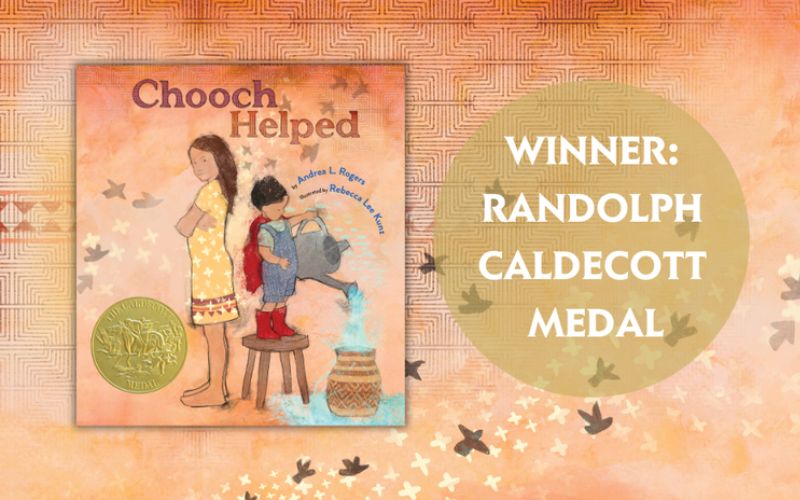Caldecott Medal Winning Illustrator Rebecca Kunz (Cherokee)
Q&A:Yahoo News

(photo/courtesy)
- By Kaili Berg
Rebecca Kunz recently became the first ever Cherokee artist to be awarded the Randolph Caldecott Medal for the most distinguished American picture book for her illustrations in Chooch Helped, a children’s book by Cherokee author Andrea L Rogers.
Chooch Helped tells the story of a Cherokee girl who reluctantly introduces her younger brother to their family’s traditions. Through her art, Kunz brings these traditions to life using a combination of watercolor, gouache, printmaking, collage, and digital illustration.
Kunz is a multimedia artist and the owner of Tree of Life Studio in Santa Fe, New Mexico. Her work is deeply influenced by traditional Cherokee iconography and archetypal symbolism.
Native News Online spoke with Kunz about her journey and inspiration behind Choonch Helped and the significance of Cherokee symbolism in her illustrations. She expressed her hope for the book and also shared her advice for aspiring artists and upcoming projects in the works.
This interview has been edited for length and brevity.
Can you just tell me a little bit about yourself and what inspired you to illustrate Chooch Helped?
I am an artist — first a painter and now an illustrator. I've been living in Santa Fe for 30 years and have been a working artist for about 20 of those years.
Chooch Helped was my first picture book, and I was inspired by the manuscript that Andrea Rogers sent me. We had met a couple of years ago, and she later sent me the manuscript, which I loved, so I was excited to work on it. It was a lot of learning, as it was a very different process from my other artwork, but I enjoyed translating the story into my own illustrations.
Congratulations on receiving the Caldecott Medal! What was your initial reaction when you found out?
I was completely shocked. I did not expect it, especially since it was my first book. I'm unbelievably honored. I've known about the Caldecott my whole life, as my mother would always bring home the Caldecott books from the library and teach us about it, so I understand the weight of it.
How did illustrating Chooch Helped compare to your previous work as a fine artist?
The biggest adjustment was working with a team — the editor, art director, and publisher. I've always worked alone before, so having an art director to guide me was new. She taught me a lot about being a visual storyteller and how the art needs to work with the text. There are a lot of nuanced details that go into making a children's book that are very different from just creating a painting.
What was your creative process to bring this story to life?
I started with sketches in my sketchbook and on my iPad using Procreate. I would then submit the sketches to my team for approval. Once approved, I worked with a combination of watercolor backgrounds, sketches, layers of color, textures, and collage elements to develop the illustrations.
Can you tell me more about the Cherokee symbolism embedded in your illustrations? What elements were particularly meaningful for you?
There are traditional Cherokee motifs and symbols throughout the book, like in the fabric of the backgrounds and on the characters' clothing. For example, the phoenix symbol on the mural page has deep meaning in Cherokee culture. I tried to interpret and use these symbols with great respect for my ancestors who created them, to imbue the story with that cultural significance.
What was the most challenging part of illustrating this book?
The most challenging was translating my personal style into what was needed for a picture book, as well as learning to draw characters and facial expressions, which was new for me.
And what was the most rewarding?
The most rewarding thing was working with the incredible team. The process was fun, joyful, and exciting.
What impact do you hope Chooch Helped has on Native and non-Native readers?
For native children, I hope they see themselves reflected in the characters and feel validated. I want to inspire them to pursue their own creative passions. For non-Native children, I hope they can relate to the characters and story, and also gain an appreciation for the slow, thoughtful process of creating art.
What advice do you have for other Indigenous artists or illustrators looking to break into children's book publishing?
My advice is to start working towards your goal, network within the industry, and don't be afraid to reach out to people. Get involved however you can, even if it's starting at the bottom, because you'll learn so much just by being around the professionals in the field.
What's next for you? Any upcoming projects you can share?
I'm currently working on a children's book biography that hasn't been announced yet. I also have another book proposal in the works. Alongside that, I'm creating artwork for a gallery show and continuing to run my business, Tree of Life Studio, where I sell my artwork and merchandise.
Is there anything else you'd like to share?
The most important advice I can give is to not give up on your dreams, even when it feels challenging. It took me 10 years of making art I didn't love before I found my true passion. Persistence and showing up consistently are key. If you have something in your heart that you long to do, just start somewhere and keep working at it.




Comments
Post a Comment
please leave a comment and we'll get back to you